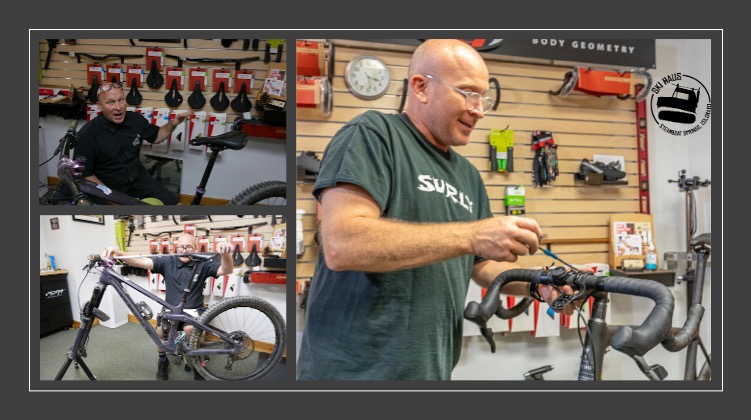
Ski Haus’s Corwin Gugel Explains Proper Bike Fitting and the Benefits for Riders of all Levels of Experience and Ability
“I came to the Yampa Valley for the winters and ended up staying for the summers.”
These words have been muttered by countless locals who moved to Steamboat Springs for bottomless, featherweight powder and ended up loving the summer months, and their recreational opportunities even more than winter.
For that reason, the locals of Steamboat Springs have developed a deep affinity for the wide variety of summer sports that the region offers. One of the most rapidly growing sports is cycling. Owing to the hundreds of miles of trails, gravel roads, and pavement it is no wonder that cyclists relish the opportunities in the Yampa Valley to pursue their two-wheeled passions.
In cycling, the bike serves as a critical interface between the rider and the road. A well-fit bike can make your riding not only a more enjoyable experience, but more efficient and healthier for your body. A poorly-fit bike, however, can make your ride uncomfortable, unenjoyable, and more importantly, unhealthy.
Far too often, those seeking two-wheeled adventures buy their “ride” based on a system of generic sizing, at-home measurements, and without even sitting on the bike to see if it has the right dynamic fit for the rider. These approaches to buying a bike can result in a riding experience that is less than desired. Even seasoned bikers, who have ridden the same bike for years, can fall into an apathetic approach in thinking “this bike fits as well as it can”, just as your’s truly assumed with my mountain bike. Regardless of skill level or style of biking, any biker can benefit from the minor, or in some cases major, adjustments that can come with a professional bike fitting.
Ski Haus has a science-and medical-based approach to bike fitting. As the leading bike retailer in the Yampa Valley, they offer a wide range of services beyond the point of purchase. Further, if you purchased a bike elsewhere, they still have an expert solution to making sure that your much-loved bike is set up “just exactly” perfect for your body at a minimal cost.
Setting up a bike is more than a “size”. It has to do with riding style, body build, past injuries, desired training outcomes, and most importantly, your “fun factor”.
Corwin P. Gugel is Ski Haus’ expert who takes fitting a bike to the next level.
John Camponeschi/for Steamboat Locals
Gugel is a life-long cyclist who moved to Steamboat in 2005. He has experienced firsthand the benefits that come with riding a properly fitted bike on roads and trail systems throughout North America. For the last 25 years of his life, he has worked with bikes and their riders, attended in-depth training, and networked with some of the top minds in the industry in order to increase his ability to ensure a safe, comfortable, and fun riding experience.
His knowledge of bike fitting is the result of a series of body geometry training sessions he attended in California. Hosted by Specialized (one of the leading bike manufacturers) in collaboration with Boulder Sports Med. and professor Dr. Andrew Pruitt, they looked at the specific details of human anatomy in a quest to understand how to take riders and their bikes and make them harmonize.
“It was all based on adjusting the bike to the human anatomy, looking at 20 steps of anatomy while looking at bone structure, flexibility, muscle, and then adjusting the bike to that,” explained Gugel. “
He explained that the hands, feet, and sit bones are the “three points of contact” in a comfortable and efficient connection with a bike and that these interfaces were crucial areas to focus on during fitting.
“The big question is how do you support those parts of the body so you get better blood flow and less nerve pinching or numbness,” he said. “Lack of blood flow and numbness of nerves can cause bigger problems down the road.”
One of the largest focuses of Gugel’s fitting has been on the saddle of the bike and ensuring that the sit bones are properly positioned for power, comfort, and to avoid negative long term health impacts. Those impacts can involve damage to the soft tissues that make almost contact with the saddle with varying degrees of force up and down, side to side, and forward to back.
John Camponeschi/Steamboat Locals
“There’s ways to measure sit bones that are really important,” said Gugel. “Just because a bike comes with a saddle doesn’t mean it’s the proper saddle for the anatomy, the angle, and how the person is sitting on the bike. One of the biggest things was to start measuring and looking at saddles from a science point of view and from a doctor’s point of view.”
The saddle shape is not the only consideration. The position and angle of the saddle can impact how a rider is spinning, knee alignment, forefoot support, and to avoid arch collapse. All of these aspects, when combined, yield power while avoiding hotspots in the foot and injuries in the leg.
“There’s ways and tools to support that,” concluded Gugel.
For many, biking is not a sport, it is a lifestyle that promotes mental health and physical fitness. Ensuring that a bike is properly fit will pay off, both in the short and long terms, in allowing the rider to enjoy an efficient ride and longevity in the sport.
Join us on September 6th for the second bike fitting feature where we take a closer look at handlebars, grips, and foot placement on the pedals.
And, if you want to know what the weather will be like for your next bike ride, don’t forget to check out our SNOWALARM Weather Blogs & Podcasts brought to you by Ski Haus!

